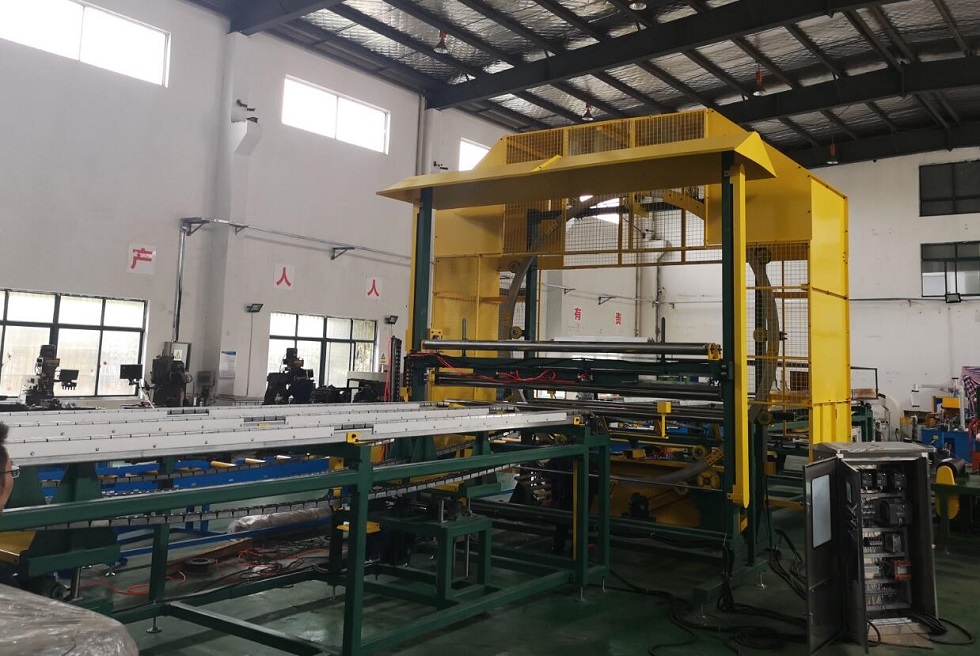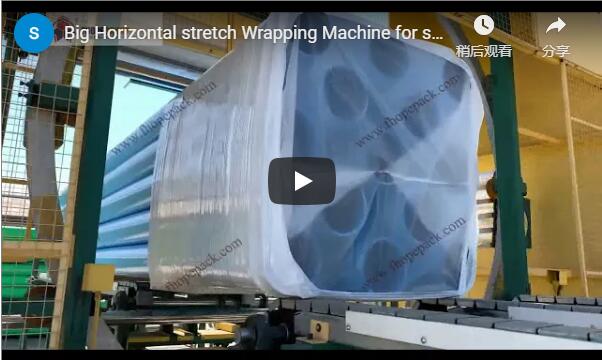Handling and securing large, heavy, or awkwardly shaped bundles like pipes, extrusions, lumber, or fabricated assemblies presents significant challenges in industrial environments. Traditional packaging methods often fall short, leading to inefficiencies, potential product damage, and safety concerns. This is where specialized equipment like a large-scale horizontal stretch wrapping machine becomes indispensable, offering automated, robust, and reliable load containment for oversized products. This overview delves into the technical aspects, design considerations, and operational experience of utilizing such a heavy-duty wrapping solution.
1. Addressing Large-Scale Wrapping Challenges
Manually wrapping oversized or heavy bundles is often impractical, time-consuming, and inconsistent. It demands significant labor, poses ergonomic risks, and rarely achieves the uniform tension required for secure transport. A heavy-duty horizontal orbital wrapper is specifically engineered to overcome these hurdles by automating the process, ensuring consistent wrap quality, and safely handling loads that would be difficult or impossible to manage otherwise. The primary application involves encasing lengthy products passing horizontally through a rotating ring carrying the stretch film roll.
2. Core Design and Structural Integrity

Built for demanding industrial applications, these machines feature a heavy-duty, welded steel frame designed for rigidity and longevity. Key structural considerations include:
- Robust Frame: Engineered to support the weight of the rotating ring assembly and withstand the dynamic forces during high-speed wrapping, often using thick-gauge steel profiles.
- Large Ring Diameter: The defining feature, the ring's internal diameter dictates the maximum cross-section of the bundle that can be processed. Ring sizes are tailored to specific application needs, often exceeding 2000mm or more for substantial loads.
- Precision Ring Drive System: Typically employs a reliable chain, belt, or direct gear drive system powered by a robust motor with variable speed control (VFD) for smooth acceleration/deceleration and precise wrap overlap control.
3. Key Components and Functionality Breakdown
Understanding the core components provides insight into the machine's capabilities:
- Rotating Ring Assembly: Houses the film carriage and drive mechanism. Its balance and smooth rotation are critical for consistent wrapping at speed.
- Film Delivery System (Carriage): This crucial component holds the stretch film roll. Advanced systems feature:
- Powered Pre-Stretch: Stretches the film before application (often up to 250-300%), maximizing film yield and improving load holding force. This significantly reduces packaging material costs.
- Adjustable Film Tension Control: Electronically or mechanically controlled to maintain consistent tension regardless of bundle shape or size.
- Easy Film Loading: Designed for quick and straightforward roll changes to minimize downtime.
- Conveyor System: Essential for automated operation.
- Type: Typically heavy-duty roller or chain conveyors designed for high load capacity (e.g., up to 6T or more, as mentioned for this specific model).
- Automation: Integrated sensors detect bundle presence, position it correctly for wrapping, and automatically convey it through the wrapping ring and onto the out-feed section. Conveyor speeds are often adjustable and synchronized with the wrapping process.
- Control System: The brain of the operation.
- PLC (Programmable Logic Controller): Provides reliable industrial control over all machine functions.
- HMI (Human-Machine Interface): Usually a touchscreen panel allowing operators to set parameters (wrap counts, overlap, tension, conveyor speed), store wrapping recipes for different products, and view diagnostics.
- Automatic Cut and Clamp Unit: Pneumatically or electrically actuated system that automatically clamps the film at the start, cuts it upon completion, and often wipes the tail to the bundle.
4. Technical Specifications Overview (Example Parameters)
While specific configurations vary, typical technical data points for a large horizontal wrapper include:
- Max. Bundle Dimensions (W x H): e.g., 1500mm x 1500mm (Varies significantly based on ring size)
- Max. Bundle Length: Often theoretically unlimited, practically determined by conveyor length.
- Max. Load Capacity: e.g., 3000kg, 6000kg (6T), or higher depending on conveyor build.
- Ring Rotation Speed: e.g., 15-50 RPM (Adjustable).
- Conveyor Speed: e.g., 5-15 m/min (Adjustable).
- Stretch Film Specifications: Standard core diameter (e.g., 76mm), film width (e.g., 500mm), roll outer diameter.
- Pre-Stretch Ratio: e.g., Up to 250% or 300% (Powered).
- Control System: PLC with Touchscreen HMI.
- Power Requirements: e.g., 480V/3Ph/60Hz (Varies by region and machine size).
- Pneumatic Requirements: e.g., 6-8 bar (for clamp/cut units).
5. Operational Workflow: Automation in Action
A typical automated cycle proceeds as follows:
- The bundle is loaded onto the in-feed conveyor.
- Sensors detect the leading edge of the product as it approaches the wrapping ring.
- The conveyors automatically position the bundle within the wrapping zone.
- The wrapping cycle initiates: the film is automatically clamped, and the ring begins rotating, applying stretch film as the conveyors move the bundle horizontally through the ring. Head and tail wrapping parameters ensure full coverage if needed.
- Once the trailing edge is detected and the programmed wrap is complete, the film is automatically cut and secured (e.g., wiped down).
- The wrapped bundle is conveyed off the machine via the out-feed conveyor.
6. Personal Insights: Operating and Maintaining the "Beast"
From an operational standpoint, these large machines, while complex, are designed for usability in industrial settings.
- Ease of Use: Modern HMIs are generally intuitive, allowing operators to easily select product recipes or adjust parameters. Initial setup and recipe programming require understanding the relationship between ring speed, conveyor speed, and desired wrap overlap.
- Film Management: Changing large film rolls requires proper lifting technique or aids, but the threading paths are usually straightforward. Monitoring pre-stretch levels ensures optimal film usage.
- Maintenance: Routine checks involve lubricating bearings and chains, inspecting rollers and belts, verifying sensor functionality, and ensuring the film cut/clamp mechanism is clean and sharp. Access panels are typically provided for maintenance points.
- Safety: These machines incorporate essential safety features like light curtains at the in-feed/out-feed, emergency stop buttons, safety interlocks on access doors, and guarding around moving parts. Proper operator training is crucial.
- Performance: The consistency and speed offered are transformative compared to manual methods. Achieving the specified 6T load capacity requires robust conveyor construction and drive systems, ensuring smooth transit without hesitation. The ability to tightly wrap bundles significantly improves load stability for transport.
7. Benefits for the Fabricator and Heavy Industry
Investing in a large horizontal stretch wrapper delivers tangible advantages:
- Improved Load Security: Consistent tension and wrap patterns secure heavy and irregular loads effectively, minimizing shifting and damage during handling and shipping.
- Enhanced Product Protection: Provides a barrier against dust, moisture, and surface abrasions. Opaque film can also offer UV protection or conceal valuable goods.
- Increased Throughput: Automation significantly speeds up the packaging process compared to manual methods.
- Reduced Labor Costs: Frees up personnel previously dedicated to manual wrapping for other value-added tasks.
- Optimized Material Usage: Powered pre-stretch systems drastically reduce film consumption compared to hand wrapping or machines without pre-stretch.
- Improved Safety: Eliminates manual handling risks associated with wrapping large, heavy items.
Conclusion: A Strategic Investment for Large-Scale Packaging
A big horizontal stretch wrapping machine capable of handling loads up to 6T represents a significant investment in packaging automation. Its robust design, specialized components like the large ring and heavy-duty conveyors, and sophisticated control systems provide an efficient, reliable, and cost-effective solution for securing oversized products common in fabrication, steel processing, lumber, and other heavy industries. By automating this critical end-of-line process, companies can enhance product protection, boost operational efficiency, and improve workplace safety.
For more detailed information and specifications on heavy-load horizontal wrapping machines tailored to specific requirements, exploring options from specialized manufacturers is recommended. You can find further details on similar systems here: https://www.fhopepack.com/Horizontal_wrapping_machine.html


